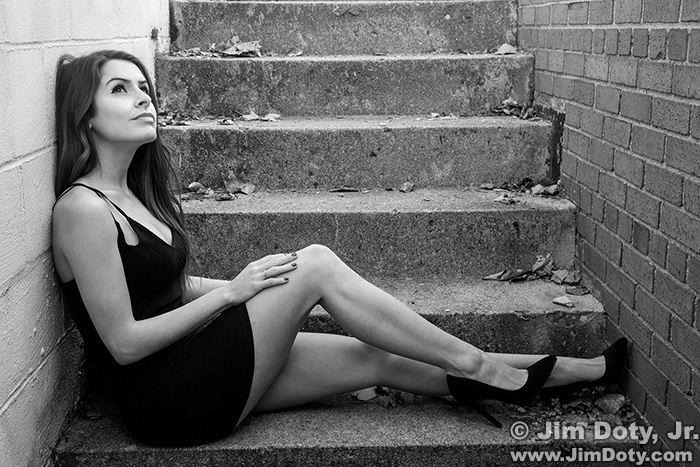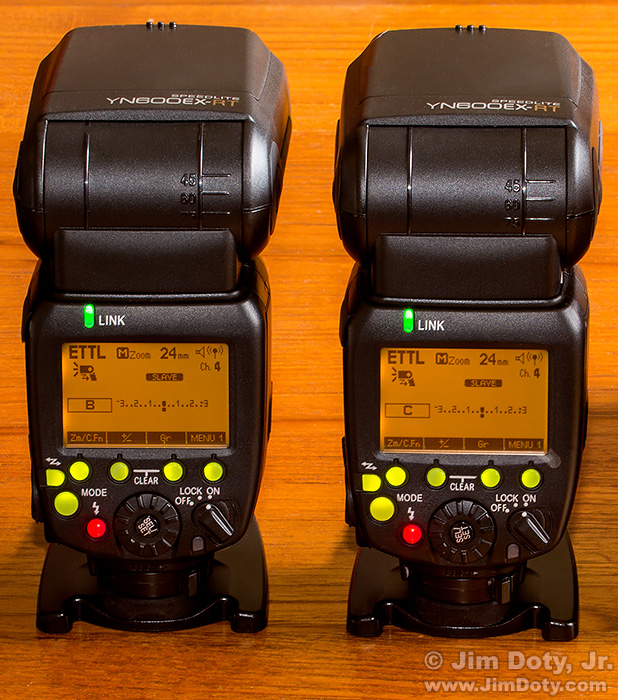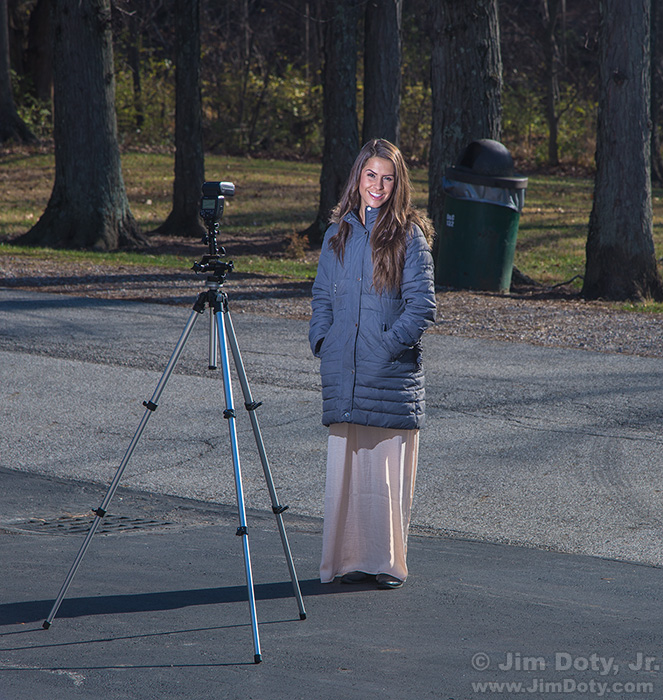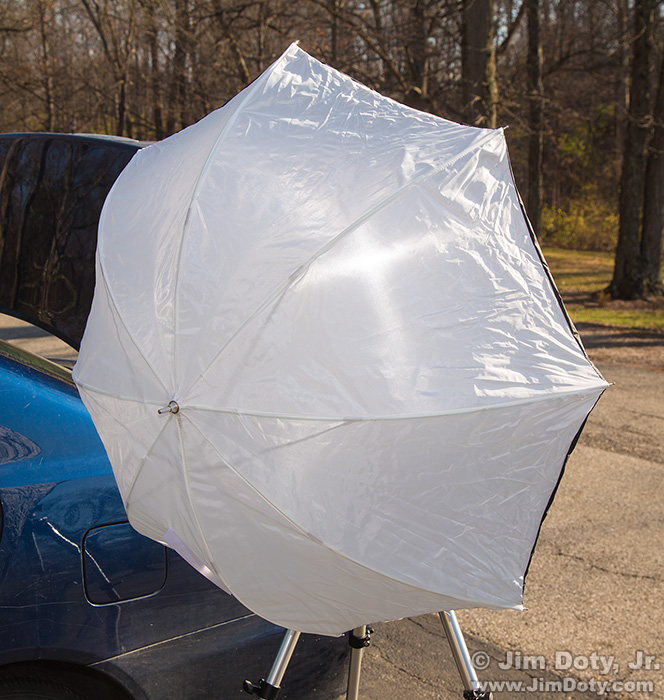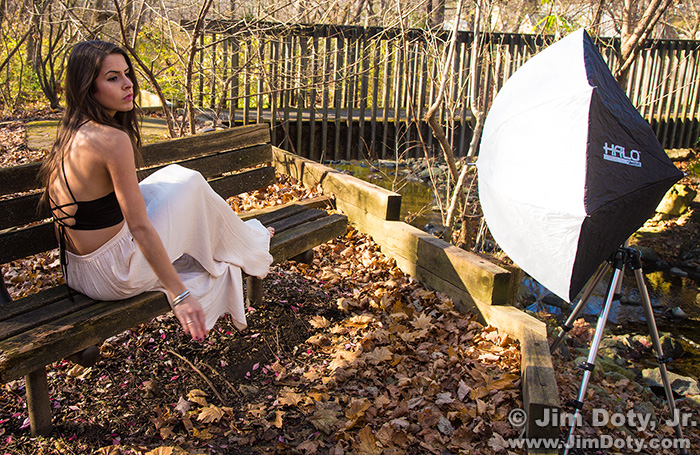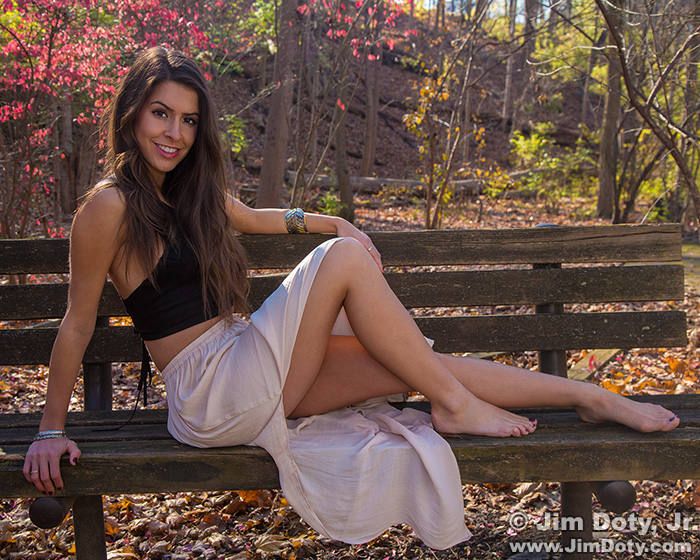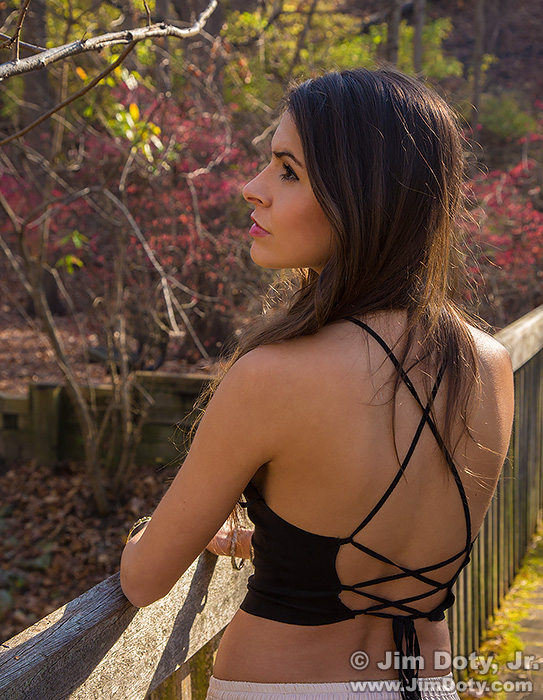
Kristina. Sunlight coming from the right. Halo softbox with Yongnuo speedlite providing light from the left.
After testing a Bob Davis 45 inch Halo Softbox and Yongnuo YN600EX-RT radio flash on my most available model (my dog), I needed to test it out on a real model. Opportunity called in the form of a message from Kristina, a professional model based in Los Angeles (and an absolute delight to work with). She would be in Ohio for Thanksgiving and she wanted to schedule a shoot. I was leaving town for Thanksgiving, but fortunately for us we had one day to shoot after she arrived and before I left.
Cloudy bright light is great for portraits. Unfortunately, our day was bright and sunny so we would have to improvise. We would shoot in the shade as much as possible and when we worked in the sunlight I would use the Halo softbox and radio controlled flash to balance the light.
Why radio? I have used an infrared flash system for years but it wouldn’t work for this project. A nice bright day effectively blinds the infrared receiver so it doesn’t see the signal from the infrared transmitter. I have learned from long experience that infrared is essentially unreliable until the sun goes down. Infrared also requires line of sight communication. With one speedlite inside the Halo softbox, it couldn’t see the infrared transmitter, even if it was at night.
The first thing I did was test the radio controlled flash system. I put one flash on my camera and set it to transmit mode and the other flash on a tripod (via an umbrella adapter) and set it to receive mode. I pointed the tripod mounted flash at Kristina, backed off about 60 feet and took a picture. Even at night infrared can have a hard time seeing as far as 25 feet, so at 60 feet it was like I had been set free. Notice how Kristina obviously looks flashed in this test shot. She is in a coat because it was 40 degrees and breezy. It was pretty much a goose bumps kind of shoot.
The next step was to put the speedlite inside an umberella and test fire it again. It worked without a hitch. If you haven’t done this before, this article shows you how to use an umbrella adapter to set up a softbox or umbrella and a speedlite on a tripod or light stand.
One of our locations was a bench in a rustic park. With dappled sunlight falling on Kristina’s back and lighting the fall leaves in the background, I metered in manual mode for the sunlight and used the softbox for fill light. Without the softbox and flash, Kristina would go very dark in the shadows. The photo immediately above shows you the set up. The purpose of the softbox is to provide very soft, even light so Kristina does not obviously look “flashed”.
Both speedlites were set for ETTL (“through the lens”, automatic flash exposure). Without changing my manual exposure for the sunlight, I could individually change the flash exposure compensation of both speedlites by using the controls on the camera mounted speedlite. I had total control. No need to get inside the Halo softbox to change the settings of that flash. Even at a distance of 50 feet or more, you can control one or more off camera speedlites from a transmitter or speedlite mounted on your camera. Most of the time I had the flash exposure compensation for the speedlite inside the softbox set for zero (no change), and I dialed down the exposure compensation for the camera mounted speedlite (generally between minus 1 and minus 2).
This is one of our favorite images. I was very impressed with the quality of light from the Halo softbox. I had the option of reversing the speedlite inside the softbox to vary the quality of the light but I didn’t need to do that. The Halo softbox is built on an umbrella frame so it is quick and simple to set up and take down. If you have tried other complicated softboxes, you know what a nuisance they can be. The Halo was designed by Bob Davis in conjunction with Westcott, hence the name.
I was introduced to the Halo softbox last March at a workshop put on by Bob Davis. I was blown away by what he could do using radio controlled speedlights in one or more of his Halo softboxes. He moved the softboxes around quite a bit to change the quality of the light and he changed the angle the softboxes to feather the light. The really cool thing was he controlled all the speedlites inside the softboxes from his camera. I knew then I wanted to do that, and I couldn’t with my Canon infrared system.
The big barrier was the price of the Canon system. Each speedlite was over $450 and the transmitter was over $250. Three speedlites and a transmitter was over $1700,a small fortune. Then I discovered the Yongnuo system. Each speedlite is $120 and the transmitter is $86. I could get three Yongnuo speedlites plus the transmitter for less than one Canon speedlite. Now that’s what I am talking about!!
A radio controlled system has so many advantages over an infrared system, and the price is ridiculously good. If you want off camera flash, what are you waiting for? Purchase links at Amazon are below.
If you have a chance to go to a seminar or workshop by Bob Davis, don’t miss it.
Article Links: Off-Camera Flash Series
“How To” Series: Off-Camera Flash – Series Introduction
Some of the Best Off-Camera Flash Equipment
Radio Controlled Speedlites: Yongnuo YN600EX-RT vs Canon 600EX-RT
Light Modifiers (Softeners) for Speedlites
Putting Together a “Studio in a Backpack”
How To Set Up a Halo Softbox or Umbrella with an Off Camera Speedlite
Photo Shoot: Using a Halo Softbox with a Yongnuo Radio Controlled Flash System
Environmental Portraits and Off-Camera Flash, Part 1
Environmental Portraits and Off-Camera Flash, Part 2
Environmental Portraits and Off-Camera Flash, Part 3
AlienBees: High Quality, Economical Studio Lights
Using the Histogram to Check Studio Flash Exposures
Purchase Links
You can order the above equipment from Amazon.com via my Amazon powered photography store. Links follow. You get the same great Amazon prices, service, guarantee, return period, plus and you help support my web sites and articles like this one. Thanks!
Yongnuo YN600EX-RT Radio Controlled Flash for Canon.
Yongnuo YN-E3-RT Radio Transmitter for Canon.
Bob Davis 45 inch Halo Softbox
LumoPro Umbrella Adapter for mounting a flash and softbox (or umbrella) on a tripod or light stand.
Wireless radio controlled speedlites for Canon, Nikon, Pentax, Fuji, and Panasonic digital cameras. Some of these are manual exposure only.
Softbox, umbrella, and other accessories for off camera flash.
Book Links
To learn more about flash, off-camera flash, studio lights and a whole lot more, read Digital Photography Exposure for Dummies, one of the highest rated photography books at Amazon.com. Learn more here and order it here.
Read the article Excellent “How To Photograph People†Books for the best books on people and portrait photography.

